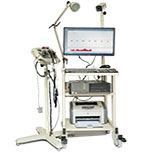Wechat QR code

TEL:400-654-1200

TEL:400-654-1200
EMG evoked potential meter
The electromyographic evoked potential meter is an instrument for determining the functional status and suspicious lesions of the peripheral neuromuscular system and the central nervous system.
Field of application
Used to determine the functional status and suspicious lesions of peripheral neuromuscular system and central nervous system, detect subclinical lesions, and accurately locate lesions. Assessment of peripheral nerve diseases, myelopathy, demyelinating diseases, cervical spondylopathy, diabetes, various types of nerve damage, evaluation of rehabilitation treatments, evaluation of sensory and motor functions, etc. Clinically, it is widely used in neurological surgery, hand surgery, orthopedics, pediatrics, rehabilitation, endocrinology, anorectal, ear, ophthalmology, urology, sexual function, forensic identification and other departments.
Features
Full compliance with the national medical safety standard GB9706.1
Full compliance with international EMG evoked potential meter specific safety standard IEC60601-2-40
A model, multiple functional modules matching for users to choose.
Can be personalized according to user needs.
Full Chinese operation interface.
EEG machine
4-channel preamplifier.
Database file management.
Parameters and requirements
Preamplifier

1, the number of channels: 4 channels
2, transmission method: optical cable transmission
3, power supply mode: the whole integrated AC power supply, the amplifier can not use battery power
4, the input impedance: ≥ 1000 megohm
5, voltage sensitivity: 0.05uv/D-10mv/D (non-display sensitivity)
6, frequency range: 0.5Hz ~ 10KHz (voltage measurement error +5% - - -15%)
7, scanning time: 1ms/D—200ms/D
8, with the electrode impedance test function
9, resolution: 24 bits
10, sampling rate: ≥ 200 kHz
11, common mode rejection ratio ≥ 115dB,
12, input short-circuit noise: ≤ 0.4μVrms (0.1-20khz)